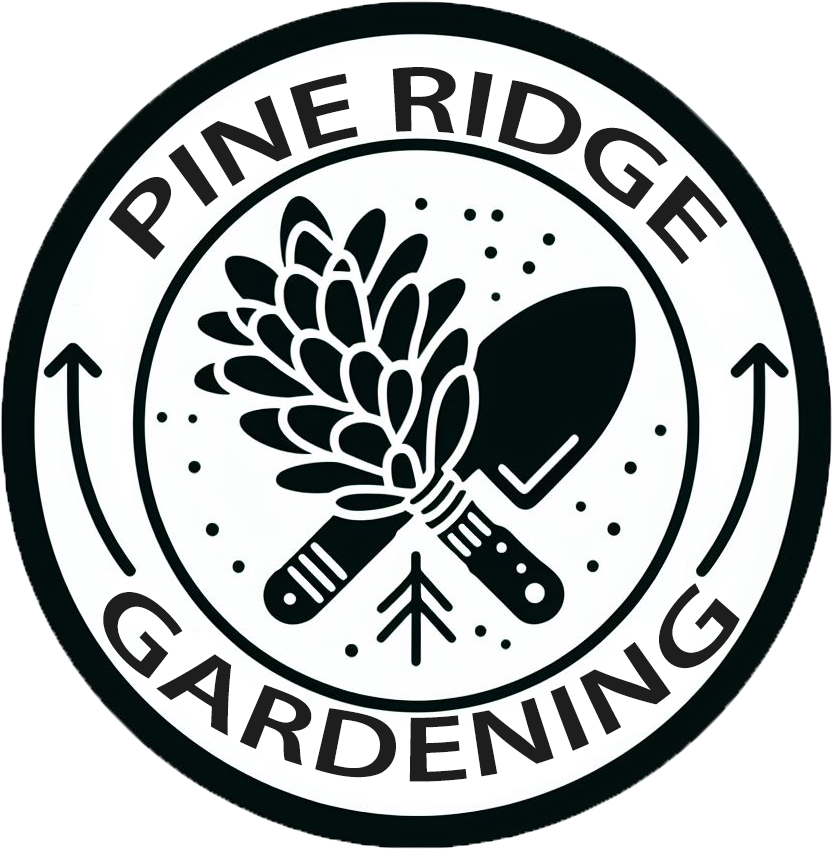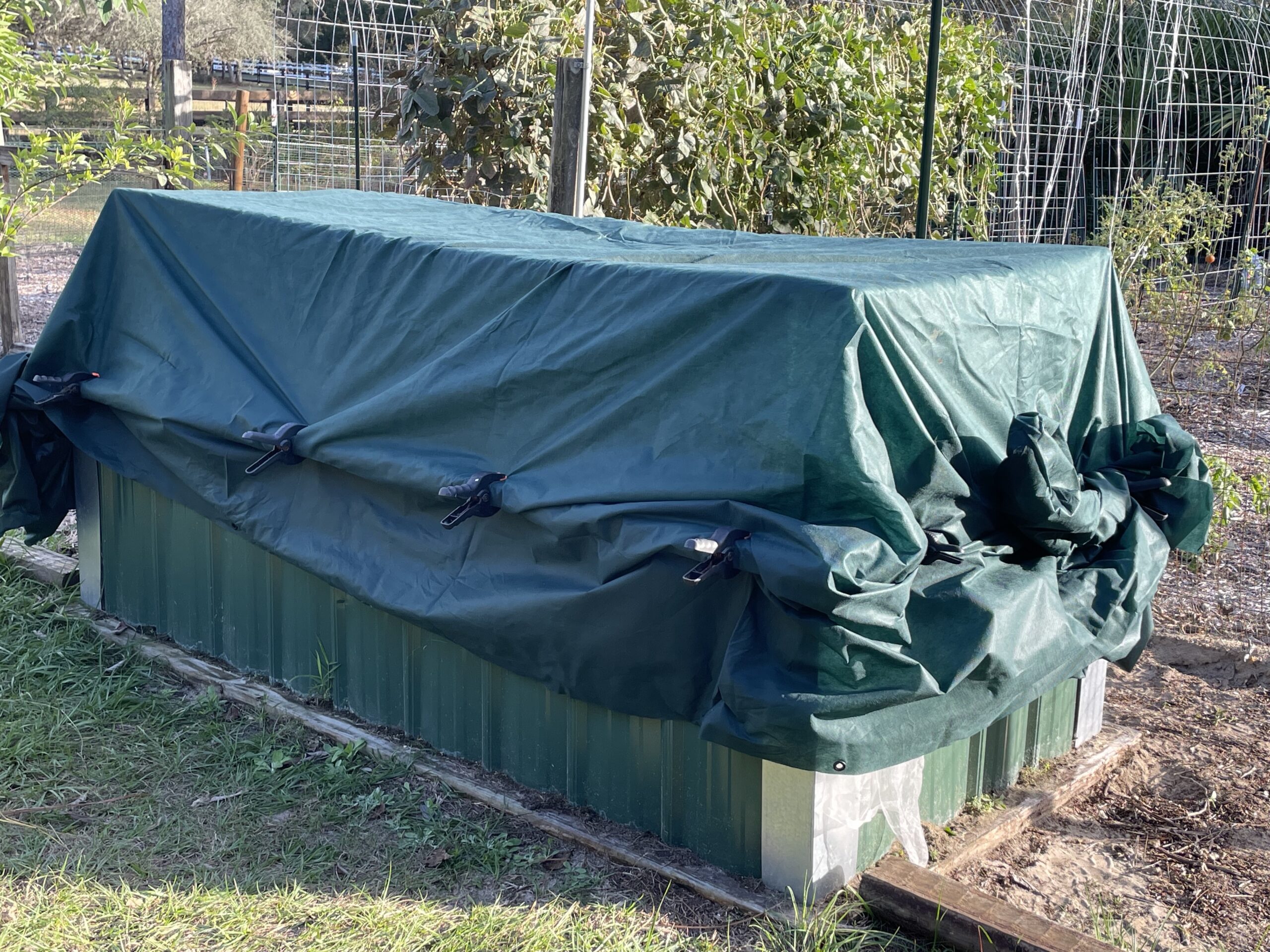Baby It’s Cold Outside
Yes, it can get cold here in Pine Ridge, Florida (zone 9a). Gardening can be challenging not knowing what to do when frost is predicted. Plant Hardiness Zone 9a means that nighttime temperatures may drop down to 20° – 25°F at some point during the winter.
Our average first frost date of the season is around December 11-20. You can expect frosts off and on until the last frost of the winter season which occurs around March 1-10. A couple of years ago we had a late frost in March which destroyed all of the blossoms on our fruit trees, so remember, these are the average frost dates.
With a light frost, when temperatures are between 32° to 36°F, tender plants will most likely be killed. This would include the warm season vegetable crops: tomatoes, peppers, green beans, cow peas, squash, cucumbers, eggplant, etc. If you still have these warm season crops in your garden and want to try to extend their growing season, they should be covered when temperatures are predicted to be 38°F or below. Hardier winter crops will show little effect from a light frost. All tropical plants, including banana, pineapple, papaya, dessert rose, and many house plants on your patio, should be moved indoors, if possible, or covered and protected by other methods before temperatures drop to 50°F or below.
A light freeze, is when temperatures are between 29° to 32°F. Tender plants will be killed at this temperature. There will be a little frost burn on most winter crops and other vegetation.
A moderate freeze, is when temperatures are between 25° to 28°F. There will be a lot of destructive effect on most vegetation. If fruit trees are in bloom, they will be heavily damaged to the point where the blossoms will eventually drop.
A severe freeze, when temperatures reach 25°F and colder, heavy damage will occur to most plants in your vegetable garden.
When to Cover Cool Season Crops
Damage to vegetation depends upon the duration of the frost as well as the humidity. The more humid the conditions, the more damage will occur.
Cool season crops (winter vegetable crops) are more susceptible to damage from cold temperatures when the plants are young, so it is a good idea to start your cool season crops early so that they can be transplanted into your garden and have time to grow before you have to worry about cold temperatures and all the work it takes to protect the young plants.
Broccoli: Cover when temperatures drop below 25°F. If plants are young, cover when temperatures are less than 29°F. Once heads form, you will need to protect the heads or harvest them, if big enough, before a frost.
Collard Greens: Collards should survive the cold temperatures in zone 9a, but if we have a bad winter, cover mature plants if temperatures will drop to 20°F or below. If the plants are still young, cover if temperatures will be below 29°F.
Kale: Cover young plants when temperatures are below 28°F. Otherwise, cover mature plants below 25°F.
Lettuce: Lettuce can withstand temperatures down to approximately 22 – 29°F, depending on the variety, so cover them if temperatures are predicted to drop below this temperature. If there is a lot of moisture in the air, you may get some burnt leaves.
Mustard Greens: Cover these greens if temperatures will drop below 28°F.
Cauliflower: These plants need to be covered when temperatures will drop to 25°F or below. The heads can be wrapped with the leaves using a rubber band to keep the leaves together protecting the cauliflower heads. Typically, cauliflower heads are wrapped anyway, otherwise the heads will turn yellow in the spring when exposed to the more intense sun. For young plants, cover if temperatures will be below 28°F.
English Peas: It all depends on the moisture in the air. If the air is dry enough, peas should survive a mild frost.
Onions: Cover when temperatures will be below 20°F to protect the green top growth. Onion will not get killed though even when temperatures drop into the middle teens. The leaves may get burned slightly, but the bulbs will be fine.
Carrots: Carrots will survive the frosts in our zone. If temperatures drop below 18 – 20°F though, it may be a good idea to cover them. It is important that the soil be well watered the day before a freeze otherwise these crops may die.
Strawberries: Cover if temperatures will be below 20°F. If they are in bloom or fruiting, you need to cover the plants if the temperatures drop to 30°F or below. Strawberries love mulch which also keeps weeds from growing.
Brussel’s Sprouts: These plants will survive the coldest temperatures we ever experience in our zone. It is not necessary to protect these plants from cold weather.
Spinach & Swiss Chard: Cover these plants if temperatures drop to 20°F or below.
White Potatoes: These plants should be planted at the beginning of February in our area, but if the temperatures drop down to 32°F or below after planting, the plants need to be covered.
Head Cabbage: Cover when temperatures drop into the low 20’s. Young plants need to be protected when temperatures drop below 29°F.
Root Crops (beets, rutabagas, turnips): These root crops are all cold hardy down to 28°F, but it is vital that the soil be well watered the day before a freeze otherwise these crops will die.
Turmeric and Garlic: The leaves will be damaged by frost, but if you heavily mulch the roots, the plants will sprout when warm weather returns in the spring.
Young Trees
Fig trees will be damaged when temperatures drop into the teens. More established fig trees will usually be alright, but you may lose a branch or two. When temperatures reach the low teens, your fig trees will most likely die back to the ground. They should grow back next year though. Since figs form on the new growth, you should be able to harvest figs on the new branches. You can protect young fig trees after the first light frost when the fig loses its leaves and becomes dormant. At this time, you can prune back the plant to a manageable size to make it easier to cover.
Loquat trees can tolerate temperatures down to 10°F if they are mature enough, but temperatures below 27°F will kill the flowers and any fruit on the tree. Small, young trees should be covered when freezing temperatures are predicted.
Citrus Trees: Temperatures below 26°F will harm most citrus trees, especially if the freeze lasts a few hours. Just like other plants, water the bare soil under citrus trees the morning before a frost. The moist soil will absorb the radiant energy from the sun and release it at night. The tree trunks of young trees, (3-years and younger), should be wrapped with a thick insulating material. Make certain that you cover the graft. See below for more steps to take to protect these trees.
How to Protect Plants
Always water plants the day before a frost is forecasted. Water is a good insulator of soil. By making sure the soil is well saturated, you are helping your plants survive a frost. Running an overhead sprinkler isn’t recommended since it is not an efficient use of water and will only help certain crops.
Mulch: Mulching perennial plants is a good way to insulate plant roots from freezing temperatures. It is not recommended for frost protection of citrus and other tropical or sub-tropical trees since radiational heating of the soil can’t occur if mulch is blocking the soil surface. Pine straw is a wonderful free material that can be used especially to protect potato plants.
Poly (clear 6 mil plastic) sheeting over hoops makes a good protective tunnel for rows of vegetable plants. The two biggest problems are that it can bake the plants and the plants can not get air. Do not let the plastic touch the plants or the cold will be transferred to the leaves and cause damage.
Bed Sheets: Lightweight bed sheets make inexpensive covering for plants, but it is best to keep the fabric away from the plants so it isn’t touching the plants. This way the cold will not be transferred to the plant leaves.
Cardboard Boxes: Boxes make inexpensive covers for individual plants and small trees. I use large wardrobe boxes to cover young trees. Cover the boxes with moving blankets or any other heavy blanket available, then tie it so that the wind will not blow it off. This method works well for small fruit trees that can not tolerate freezing temperatures. Incandescent string lights can be strung inside the box to provide heat as long as the bulbs are not touching the leaves. Unfortunately, it is difficult to find incandescent string lights these days. The boxes need to be removed during the day as long as temperatures are warm enough.
Frost Fabric: Frost fabric, typically called Row Cover Fabric, needs to be a “floating” cover. Keep the fabric from touching plants by using hoops made from pvc, rebar or premade hoops. Anchor the ends and edges with weed fabric staples (sod staples), or bricks. Frost fabric is breathable, so it is the best choice of material to protect plants from frost. When it warms up, remove the fabric so the plants will not bake and so they will receive enough sun. I buy frost fabric made by Agribon which comes in four different weights, depending on the amount of frost protection you need in your planting zone.
Where to Purchase Frost Protection Supplies
Amazon, Lowe’s and Home Depot all carry frost fabric.

Hoops
These hoops are available in different sizes and quantities. Plastic coated steel, durable, lasts a long time.

Frost Fabric Row Covers
Agribon, comes in different thicknesses for various degrees of frost protection. It is reusable, can be cut into lengths to cover your raised beds or potted plants, or over hoops to cover garden rows. In zone 9a, we typically only need AG-19 for our vegetable plants, but you may want to purchase denser frost fabric for more sensitive plants such as AG-30 (4-6°F of frost protection), AG-50 (6-8°F of frost protection) or AG-70 (8+°F of frost protection).AG-19 (up to 4°F of frost protection):

Plant and Tree Covers

Row Cover Hoop Clips
Row Cover Frost Fabric Hoop Clips To Support Frost Fabric 40 Pc
For an updated, easy to read, temperature threshold chart for cool season vegetable plants, check out my blog, When to Protect Your Cold Season Garden From Frost and Freezing Temperatures.


